Pol Detienne, Tarcienne, Belgium, Europe
Yes, we do have our own hybridizer, here in Belgium!

His name is Pol Detienne and he is born in the French speaking region of Belgium, nearby Charleroi. We wanted to visit him for a long time now. Can you think of a better time than when two American waterlily-freaks come to visit?
Together with Larry Nau and Zac Degarmeaux we went straight from the airport to Tarcienne. No better way then our curvy roads to make two tired Americans fall asleep. Once we arrived, it quickly turned into a cosy afternoon. Although we all speak different languages when it comes to waterlilies, we understood each other perfectly.
Throughout the years Pol Detienne specialized in daylilies and a lot of the old ponds disappeared to make more room for his collection of day lilies. Still there is a great collection left. His own hybrids are of course worthwhile. It turned into a great afternoon of sharing knowledge, making jokes and of course enjoying all the beauties we were surrounded with. It’s worth visiting this nursery with a big collection on limited space.
The history
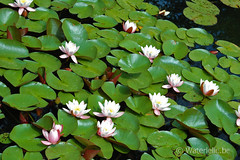
His love for aquatics started in his childhood, while playing near the ponds and in the woods of Loveral. These ponds were deserted and had a diverse aquatic vegetation, that immediatly caught his attention. In 1967, he started his aquarium business in importing tropical fishes from Singapore, the Philippines and Sri-Lanka. In 1975 he constructed his first watergardens in his backyard. At that time it was still more of a hobby than a business. He planted aquatics he found in the wild and waterlilies he received from friends. He bought his first waterlilies from a nursery in the Netherlands, unfortunately they weren’t truly named. So he searched for other suppliers in Germany and the United Kingdom. His first waterlilies were Gladstoniana, René Gérard, Marliacea Rosea, Marliacea Chromatella and Charles de Meurvilles. Round 1980, he started with his nursery for aquatics and he also created watergardens with the pools man-made in polyester in place. He was the first in the region to use that technique. In 1992 he stopped selling tropical fishes and spent more time in his nursery together with his wife Danielle. They also increased the production of perennials, he has more than 850 varieties of daylilies and more than 80 hostas. In 2005 he wrote the book “Les Nymphéas Rustiques” in which he describes 50 cultivars, their origin, taxonomy, culture, maintenance, parasites and deseases,… The book was published by Belgique Editions and counts 130 pages all dedicated to these 50 vaireties of hardy waterlilies.
The nursery
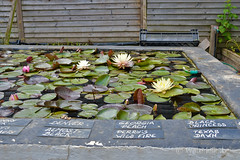
Visitors can enjoy his little paradise of 2500 square metres during summer from 15th June until the end of July. Where they can enjoy more then 125 varieties of waterlilies, 850 daylilies, 80 Hostas, appel trees, magnolias, and about 120 other rare ones grown in his garden. Mr Detienne gives guided tours that take about an hour and a half and you are free to ask all the questions you want afterwards. The nursery itself is open from 1st of March until 31th of October and is about 800 square metres. The waterlilies are sold in containers of 22 to 30 cm diametre.
Hybridizing

I’ve noticed the development of seeds on different varieties in my ponds. First I’ve tried to sew harvested seeds from different pods of waterlilies. The results were disappointing. So I searched for information about hybridizing in different books, especially Perry Slocums. I also took precautions, like putting the flower into a nylon sock after fertilization. I’ve put the seeds on a bed of riversand with a little bit of water and covered the container with glass. The percentage of germination was acceptable. A few weeks in the greenhouse was enough to get little seedlings After repotting them in a mixture of silty and sandy soil , under 2 cm of water, the seedlings developed quickly.

After 3 to 4 years of cultivation and repotting, the young waterlilies came to flower. Most of them were pretty common, even less beautiful than the parents! But a few of them seemed to have potential. These ones were brought to adult size. One of them became Pol’s Pink Glory of which I am very proud!. Until the mid 90’s I’ve harvested seeds this way or through natural fertilazation. Having at that time allready 120 varieties, chance seedlings were inevitable. I also did a few crosses on purpose; Purple Queen is an example of such a cross. The genetics of waterlilies is so complicated and the parentage so dubious sometimes , that I’ve let nature take its course.
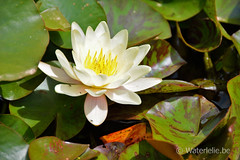
After 15 years of disappointment for a few successes, I’ve stopped trying hybridizing waterlilies. At that time I was already more into daylilies, where the newest american cultivars awakened a new passion in me. I did not entirely gave up on my waterlilies and could’nt resist on expanding my collection with new varieties from Kirk Strawn and P. Slocum that I pruchased while I was visiting colleagues of daylilie hybridizers in the United States.
Pools
Pools My first 4 pools had a surface of 15 to 25 square metres and a volume of 8.000 to 12.000 litres. The fifth pool constructed in 1985 was about 70 square metres and 50.000 litres. In the nursery the pools were between 3.000 and 50.000 litres. The 4 biggest ones dissapeared to create more place for the daylilies.
Tropicals
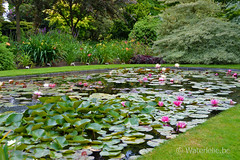
At the time that we imported fish from the Phillipines, Singapour and Shri Lanka, I had the opportunity to receive some tropical waterlilies and lotuses for free. Because I didn’t have a greenhouse to protect them during winter, they passed their summer outside, where I enjoyed their flowers of that year. They never got through winter and I have never insisted.
Favourits
I love almost all my waterlilies in my collection , and I have more then 200! But anyway, if I have to choose, I would go for Blushing Bride, Mangkala Ubol, Sunny Pink, Perry’s Fire Opal, Innerlight and Black Princess. And of course my own Pol’s Pink Glory, the best bloomer of all! But once again I love them all, especially the crosses of Kirk Strawn and Perry Slocum.
Trips
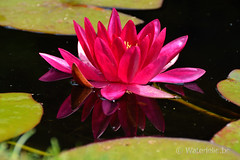
Sometime ago (about 20 years) I’ve visited nurseries in the United Kingdom and Germany. More recent my trips to the United States, devoted to my colleagues of daylilies hybridizers, made me appreciate beautiful gardens and nurseries of aquatic plants, Florida Aquatic Nurseries for instance. They are in their own way better than here in Belgium, and the prices are also very interesting!
To have and to hold list
I still have about 150 varieties and the biggest part of the garden is going to the daylilies now, but I would still find some place for a Wanvisa, Gregg’s Orange Beauty or Pink Grapefruit. A little trip to Germany to Jörg Petrowsky, Nymphaion or Christian Meyer might be necessary
Wil je meer weten over deze uitzonderlijke waterleliliefhebber of ben je benieuwd naar zijn eigen kruisingen, kijk dan even hieronder.







